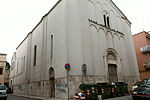Stadio Degli Ulivi
Football venues in ItalyItalian sports venue stubsMulti-purpose stadiums in Italy

Stadio Degli Ulivi is a multi-purpose stadium in Andria, Italy. It is mainly used for football matches and hosts the home matches of Lega Pro side Fidelis Andria. The stadium has a capacity of 9,140 spectators.
Excerpt from the Wikipedia article Stadio Degli Ulivi (License: CC BY-SA 3.0, Authors, Images).Stadio Degli Ulivi
Piazzale della Repubblica, Andria
Geographical coordinates (GPS) Address External links Nearby Places Show on map
Geographical coordinates (GPS)
| Latitude | Longitude |
|---|---|
| N 41.2325 ° | E 16.309166666667 ° |
Address
Stadio degli Ulivi
Piazzale della Repubblica
76123 Andria
Apulia, Italy
Open on Google Maps








